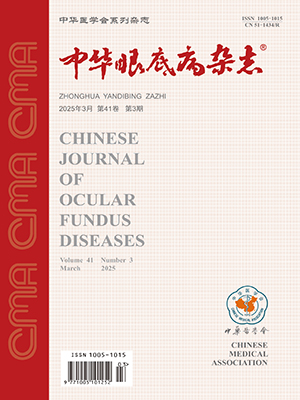| 1. |
中华医学会肾脏病学分会专家组. 糖尿病肾脏疾病临床诊疗中国指南[J]. 中华肾脏病杂志, 2021, 37(3): 255-304. DOI: 10.3760/cma.j.cn441217-20201125-00041.Chinese Society of Nephrology Expert Group. Chinese guidelines for diagnosis and treatment of diabetic kidney disease[J]. Chin J Nephrol, 2021, 37(3): 255-304. DOI: 10.3760/cma.j.cn441217-20201125-00041.
|
| 2. |
Santos MMR, Cavalcante ACFPS, Amaral LAD, et al. Combination of cafeteria diet with intraperitoneally streptozotocin in rats. A type-2 diabetes model[J/OL]. Acta Cir Bras, 2021, 36(7): e360702[2021-08-23]. https://pubmed.ncbi.nlm.nih.gov/34431921/. DOI: 10.1590/ACB360702.
|
| 3. |
Olivares AM, Althoff K, Chen GF, et al. Animal models of diabetic retinopathy[J]. Curr Diab Rep, 2017, 17(10): 93. DOI: 10.1007/s11892-017-0913-0.
|
| 4. |
Matboli M, Eissa S, Ibrahim D, et al. Caffeic acid attenuates diabetic kidney disease via modulation of autophagy in a high-fat diet/streptozotocin- induced diabetic rat[J/OL]. Sci Rep, 2017, 7(1): 2263[2017-05-23]. https://pubmed.ncbi.nlm.nih.gov/28536471/. DOI: 10.1038/s41598-017-02320-z.
|
| 5. |
He M, Long P, Guo L, et al. Fushiming capsule attenuates diabetic rat retina damage via antioxidation and anti-Inflammation[J/OL]. Evid Based Complement Alternat Med, 2019, 2019: 5376439[2019-07-18]. https://pubmed.ncbi.nlm.nih.gov/31396288/. DOI: 10.1155/2019/5376439.
|
| 6. |
Kowluru RA. Retinopathy in a diet-induced type 2 diabetic rat model and role of epigenetic modifications[J]. Diabetes, 2020, 69(4): 689-698. DOI: 10.2337/db19-1009.
|
| 7. |
中国微循环学会糖尿病与微循环专业委员会, 中国医疗保健国际交流促进会基层卫生分会基层糖尿病学部, 江苏省基层内分泌特色科室孵化联盟. 基层糖尿病微血管病变筛查与防治专家共识(2021年版)[J]. 中国医学前沿杂志(电子版), 2021, 13(6): 16-38. DOI: 10.12037/YXQY.2021.06-04.Diabetes and Microcirculation Professional Committee of the Chinese Society of Microcirculation, Primary Diabetes Department of the Primary Health Branch of the China Association for the Promotion of International Exchanges in Healthcare, and the Incubation alliance of primary endocrine specialty departments in Jiangsu Province. Expert Consensus on Screening and Prevention of diabetic microangiopaopathy (2021 edition)[J]. Chinese Journal of the Frontiers of Medical Science (Electronic Version), 2021, 13(6): 16-38. DOI: 10.12037/YXQY.2021.06-04.
|
| 8. |
Shi Y, Vanhoutte PM. Macro-and microvascular endothelial dysfunction in diabetes[J]. J Diabetes, 2017, 9(5): 434-449. DOI: 10.1111/1753-0407.12521.
|
| 9. |
Forbes JM, Cooper ME. Mechanisms of diabetic complications[J]. Physiol Rev, 2013, 93(1): 137-188. DOI: 10.1152/physrev.00045.2011.
|
| 10. |
孙静文, 孙铭良, 袁静云, 等. 糖尿病视网膜病变与糖尿病肾病发病相关性研究[J]. 中华中医药杂志, 2020, 35(1): 350-352.Sun JW, Sun ML, Yuan JY, et al. Correlation study between diabetic retinopathy and diabetic nephropathy[J]. Chin J Trad Chin Med Phar, 2020, 35(1): 350-352.
|
| 11. |
Hsieh YT, Hsieh MC. Time-sequential correlations between diabetic kidney disease and diabetic retinopathy in type 2 diabetes -an 8-year prospective cohort study[J/OL]. Acta Ophthalmol, 2021, 99(1): e1-e6[2021-02-01]. https://pubmed.ncbi.nlm.nih.gov/32567151/. DOI: 10.1111/aos.14487.
|
| 12. |
郭振红. OLETF大鼠糖尿病肾病发生发展不同阶段视网膜的病理学改变及机制探讨[D]. 天津: 天津医科大学, 2016.Guo ZH. OLETF pathological changes and mechanism of retina in different stages of diabetic nephropathy in rats[D]. Tianjin: Tianjin Medical University, 2016.
|
| 13. |
Galicia-Garcia U, Benito-Vicente A, Jebari S, et al. Pathophysiology of type 2 diabetes mellitus[J/OL]. Int J Mol Sci, 2020, 21(17): 6275[2020-08-30]. https://pubmed.ncbi.nlm.nih.gov/32872570/. DOI: 10.3390/ijms21176275.
|
| 14. |
黎娅, 范培云, 马晓雨, 等. 长期稳定的SD大鼠2型糖尿病模型制备方法[J]. 中国实验动物学报, 2020, 28(3): 364-369. DOI: 10.3969/j.issn.1005-4847.2020.03.011.Li Y, Fan PY, Ma XY, et al. A long-term and stable method for the preparation of a type 2 diabetes Sprague-Dawley rat model[J]. Acta Lab Anim Sci Sin, 2020, 28(3): 364-369. DOI: 10.3969/j.issn.1005-4847.2020.03.011.
|
| 15. |
Junod A, Lambert AE, Stauffacher W, et al. Diabetogenic action of streptozotocin: relationship of dose to metabolic response[J]. J Clin Invest, 1969, 48(11): 2129-2139. DOI: 10.1172/JCI106180.
|
| 16. |
祁珊珊, 何佳, 孙泽, 等. 糖尿病肾病SD大鼠模型的建立和评价[J]. 中国临床药理学杂志, 2021, 37(9): 1114-1116, 1125. DOI: 10.13699/j. cnki.1001-6821.2021.09.021.Qi SS, He J, Sun Z, et al. Establishment and evaluation of SD rat model of diabetic nephropathy[J]. Chin J Clin Pharmacol, 2021, 37(9): 1114-1116, 1125. DOI: 10.13699/j.cnki.1001-6821.2021.09.021.
|
| 17. |
段惠惠, 黄建梅, 于素云, 等. STZ糖尿病大鼠视网膜病变模型的再评价[J]. 中国比较医学杂志, 2013, 23(5): 12-18. DOI: 10.3969/j.issn.1671-7856.2013.05.003.Duan HH, Huang JM, Yu SY, et al. Revaluation of experimental animal model of diabetic retinopathy induced by STZ rat[J]. Chin J Comp Med, 2013, 23(5): 12-18. DOI: 10.3969/j.issn.1671-7856.2013.05.003.
|
| 18. |
Koulmanda M, Qipo A, Chebrolu S, et al. The effect of low versus high dose of streptozotocin in cynomolgus monkeys (Macaca fascilularis)[J]. Am J Transplant, 2003, 3(3): 267-272. DOI: 10.1034/j.1600-6143.2003.00040.x.
|
| 19. |
Goyal SN, Reddy NM, Patil KR, et al. Challenges and issues with streptozotocin-induced diabetes-a clinically relevant animal model to understand the diabetes pathogenesis and evaluate therapeutics[J]. Chem Biol Interact, 2016, 244: 49-63. DOI: 10.1016/j.cbi.2015.11.032.
|
| 20. |
Gheibi S, Kashfi K, Ghasemi A. A practical guide for induction of type-2 diabetes in rat: Incorporating a high-fat diet and streptozotocin[J]. Biomed Pharmacother, 2017, 95: 605-613. DOI: 10.1016/j.biopha.2017.08.098.
|
| 21. |
Sugano M, Yamato H, Hayashi T, et al. High-fat diet in low-dose-streptozotocin-treated heminephrectomized rats induces all features of human type 2 diabetic nephropathy: a new rat model of diabetic nephropathy[J]. Nutr Metab Cardiovasc Dis, 2006, 16(7): 477-484. DOI: 10.1016/j.numecd.2005.08.007.
|
| 22. |
高雪, 安至超, 何其英, 等. 高脂饲料喂养时间对2型糖尿病肾病大鼠模型的影响[J]. 中国实验动物学报, 2018, 26(1): 114-119. DOI: 10.3969/j.issn.1005-4847.2018.01.018.Gao X, An ZC, He QY, et al. Effects of high fat diet feeding time on the establishment of a rat model of type 2 diabetic nephropathy[J]. Acta Lab Anim Sci Sin, 2018, 26(1): 114-119. DOI: 10.3969/j.issn.1005-4847.2018.01.018.
|
| 23. |
王保伟, 李颖, 刘晓红, 等. 高脂饲料喂养时间及链脲佐菌素剂量对实验型2型糖尿病大鼠造模的影响[J]. 卫生研究, 2011, 40(1): 99-102, 106. 10.19813/j. cnki. weishengyanjiu. 2011.01. 025.Wang BW, Li Y, Liu XH, et al. Effect of the duration of high-fat diet and the dosage of streptozotocin on establishing experimental animal model of type 2 diabetes mellitus[J]. Journal of Hygiene Research, 2011, 40(1): 99-102, 106. 10.19813/j. cnki. weishengyanjiu. 2011.01. 025.
|
| 24. |
何萌杉. 复视明胶囊对糖尿病视网膜损伤的改善作用及其机制研究[D]. 西安: 中国人民解放军空军军医大学, 2019.He MS. Study on the ameliorating effect of Fushiming capsule on diabetic retina injury and its mechanism[D]. Xi'an: Air Force Medical University, 2019.
|
| 25. |
Cai X, McGinnis JF. Diabetic retinopathy: animal models, therapies, and perspectives[J/OL]. J Diabetes Res, 2016, 2016: 3789217[2016-01-06]. https://pubmed.ncbi.nlm.nih.gov/26881246/. DOI: 10.1155/2016/3789217.
|




